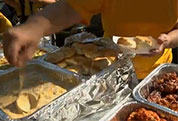
SUNDAY, Nov. 18 (HealthDay News) — Having sufficient cooler space and ice packs are essential for ensuring food safety during a tailgate party, say experts from the Institute for Food Safety and Health at Illinois Institute of Technology.
Whether you dish out food prepared beforehand or cook it alongside your car in a stadium parking lot, this popular American pastime requires careful planning, said Robert Gravani, a professor of food science at Cornell University and spokesman for the Chicago-based Institute of Food Technologists.
According to the food-safety experts, safety precautions tailgaters should take to prevent foodborne illnesses include the following:
- Make sure coolers are clean and free of standing water.
- Separate perishable food from drinks and foods that are ready to eat.
- Pack meats separately from raw fruits and vegetables.
- Carefully seal sandwiches and other prepared foods.
- Pack mayonnaise and similar items last and keep them on top of other foods in the cooler. Mayonnaise is acidic and helps protect food against bacteria and viruses, the experts noted, but it should be refrigerated before and after a meal.
- Don’t bring much more food than needed.
- Bring a food thermometer to test prepared foods before eating. Be sure to cook hamburgers or hot dogs to an internal temperature of 160 degrees.
- If hamburgers are on the tailgate menu, buy preformed patties to minimize the handling of raw meat.
- Use hand sanitizers, antibacterial wipes and disposable gloves to ensure the safe handling of raw foods.
- Avoid cross-contamination by cleaning your hands after touching raw meat, throwing gloves away after using them, and throwing away any foods that fall on the ground or touch an unclean surface.
- Refrigerate prepared foods within two hours. Cooked foods should not be left out for more than two hours, according to the U.S. Department of Agriculture.
- Consider using a crockpot (even one that is unplugged) to keep foods warm.
- Wrap up and refrigerate leftovers once tailgating ends. If there is any doubt about the safety of a food, it should be thrown away.
More information
The U.S. Centers for Disease Control and Prevention provides more information on food safety.

